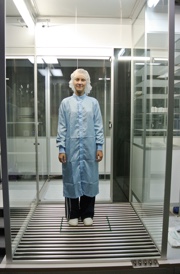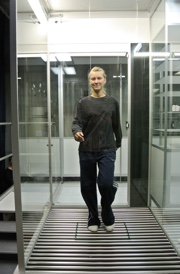It is well established that humans are the biggest source of contamination in cleanrooms, irrespective of whether that contamination arises from airborne particles or is microbiological. The key function of cleanroom garments, therefore, is to protect clean processes from the contamination from personnel and their clothing. Their effectiveness in doing this has been shown in a very extensive study carried out in 2010 using a particle counter in a ‘Body Box’. Another recent study looked at how the average particle release per minute of an employee varied based on the garment being worn and the movement being performed, the results of which are summarised in Table 1.
From a microbiological point of view, this study begs the question whether any conclusion can be made based on these figures regarding possible microbiological count. However, this question could not be empirically tested or proven with the results available at that time.
There are studies in the literature on this topic that derive a theoretical connection, but to date there has been no study that provided test results of microbial release in a similar way to that of particle release, measured with a particle counter. This task caught the attention of Dastex and a further Body Box study was made in 2014.
The crucial factor for the feasibility of the study was the introduction of a new measuring device supplied by TSI: the Biotrak 9510-BD. With this particular counter it was now possible to quantitatively record and evaluate airborne germs. Interestingly, the Biotrak device can record quantitatively not only airborne germs but also airborne particles, therefore the results could be separated into viable and non-viable contamination.
An interesting question that arose was whether there is a direct correlation between the contamination coming from humans and the microbial release of the person in the study; if so a kind of conversion factor could be obtained.
Study design
The Body Box method can be summarised as follows: the box provides an extremely clean space within a very restricted area (approx. 1.20 x 1.20 x 2.40m), just big enough for one person. The construction of the box, which includes a fan filter unit (FFU) in its ceiling and a special floor construction, ensures that there is a constant low turbulence air stream that is expelled.
Before the real measurements start, the Body Box is run in an ‘at rest’ mode, with nobody in it. In a relatively short time, constant environmental conditions are created that correspond to air cleanliness classes ISO3/ISO4 (ISO 14644-1). The reference measurements are carried out before every test series to confirm that this high level of air quality has been attained. Once a person enters the Body Box, all subsequently measured airborne contamination must, therefore, have been released by this person and the worn garments.
An additional challenge for the measurement of the microbiological contamination was to make the inside of the Body Box as sterile as possible, as well as the inside of the return air chamber and the test point where the contamination would be measured. Any potential cross-contamination, and consequently errors of measurement, should be avoided as far as possible. For this reason UVC lamps were installed at several points in the measuring system. So before every measurement with the sterile cleanroom garment, the direct environment around the measuring points was subject to several minutes of UVC light to disinfect the whole area, including points that could not have been reached with disinfection wipes.
To ensure the success of the UVC light disinfection, a reference measurement was made before every test series. Also, the air stream was tested with the counter to prove that, before any person had entered the Body Box, the environment was free of microbiological contamination.
Repeated test cycles
For the study, three standard garment systems were defined, and these were tested several times. To ensure reliable results were obtained with the Body Box, 10 repeated cycles were determined per person and garment system. It is known that the particle release and/or germ contamination levels can vary a lot from person to person, but also that the range from one person can fluctuate a great deal. Therefore, it is advisable to run as many tests as possible with the same person and garment system to obtain a reliable average.
Despite the repetitions, the standard deviation is still pretty high and this should be borne in mind during later interpretation of the values. While no absolute values can be measured, with the help of the Body Box measurements some well-grounded evaluations can be made.
The experiment
Three typical garment systems were compared. The first garments to be tested were simple, standard ‘street’ clothes. To provide a simple and readily repeatable garment system, these were simulated using jogging suits made of 100% cotton.

Here the tests being run are on a person standing while wearing a cleanroom gown and bouffant cap

Here the tests being run are on a person walking slowly while wearing ‘street’ clothes
For the second system, a cleanroom coat, bouffant cap and cleanroom shoes where worn in addition to the cotton jogging suit, and the results were analysed. The third garment system consisted of a cleanroom suitable undergarment (made of a combination of two different materials, both based on synthetic fibres) as well as a coverall, a full cover hood and overboots, all made of a cleanroom fabric that is mostly used in A/B areas. This system was completed with nitrile gloves, a sterile disposable face mask as well as goggles, so that no human skin was left uncovered.
After entering the Body Box, every proband had five minutes for acclimatisation. During this time no contamination was measured due to the fact that while entering the box, contamination from outside could have travelled in as well. After five minutes, the measurement started with the person carrying out different movements for 30 minutes for each exercise. A slow and easy walk followed by standing calm and still were simulated in turn. The recorded values were analysed accordingly as ‘walking’ and ‘standing’. In view of the expected high fluctuation range of the values, at least 10 cycles were scheduled per person and garment system version.
Results
Due to the relative high purity of the air (continuously loaded by the FFU to the measuring system) and sample volume (a particle counter can only measure 28L/min) the results were grossed up to the count of particles or germs released per m3 of air (as summarised in Table 1). As in the study of 2010 (where only airborne contamination was analysed) the differences between the three garment systems are significant. Once again this makes it clear that humans in a cleanroom are a major contamination risk in terms of both particle and microbial contamination.

Demonstration of efficiency
The efficiency of today’s cleanroom garment systems has also been demonstrated – a reduction to 1% was noted for germs in the size range of 1µm or larger, and even a reduction to 0.3% for germs of 5µm or larger. However, the results also show that a 100% protection or retention of microbiological contamination is not possible even with very good cleanroom garments.
While analysing the particle contamination caused by the test person wearing the different garment systems (which was measured at the same time), two points were notable:
- 1. People with high particle contamination also spread a lot of microbiological contamination into their direct environment
- 2. On the basis of the current results, no direct correlation coefficient was recognisable.
As no other such investigations using this testing method have been carried out, a comparison with other studies is not possible. However, the assumption that high particle releases from one person are accompanied by a higher microbiological contamination load has been proven empirically. The efficiency of a proper cleanroom garment system has also been proved.
Another interesting question arising out of this study is whether the evaluation of the recorded values could be directly compared with the available monitoring data of pharmaceutical areas (which normally show a significantly lower bacterial count during environmental monitoring). Here, the different measurement processes are surely both worth comparison and consideration.
The measurement process
Measurement using TSI’s Biotrak is based on an auto-fluorescence method. The fluorescence of micro-organisms is stimulated with the help of a high quality diode laser of a certain wavelength (violet light). The setting of this counter is comparable to an optical particle counter. The short-wave laser (for stimulation of the natural fluorescence) is the significant difference. In addition to live airborne germs with active metabolism, including spore forms, this counter also records injured or dead micro-organisms. Consequently, the results are significantly higher compared with those achieved using conventional methods with nutrient solutions. The essential advantage of this method is that the record is carried out in real-time and possible deviations can be recognised significantly earlier and so corrective action can be taken much sooner.
Biotrak 9510-BD is a registered trademark of TSI.




